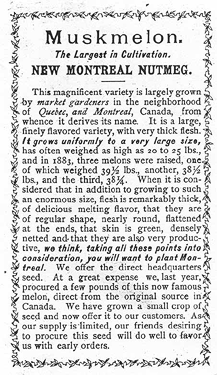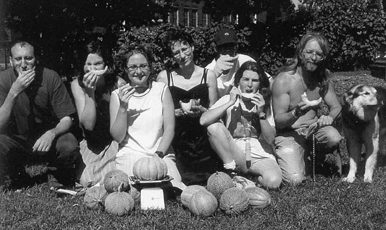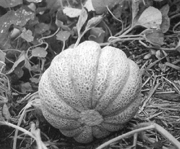
by Gwynne Basen
Reprinted with permission of Seeds of Diversity Canada
 |
|
The melon's roots can be traced back to varieties brought over by French settlers in the seventeenth century. In its heyday, half a century ago, the Montreal melon was the Queen of Melons. Its delicious, green flesh was prized in the fancy dining rooms of New York and Boston, where customers would pay a big price for the pleasure of eating just a single juicy slice. A 1938 handbook Vegetables of New York claimed that "handled skillfully and intelligently, the melon produces the largest fruits of its type in American cultivation." A single melon could easily reach 15 pounds! And its unique spicy flavour was the reason it was also known as "The Montreal Nutmeg Melon."
But styles change. Green-fleshed melons lost their appeal. Small farm production was being overtaken by a more industrial form of agriculture. This was a melon that needed daily attention from the grower. The thin rind required careful handling. Special woven baskets were produced for shipping the fruit. And it didn't store well. In Montreal, the rich farmlands where the
 |
|
So, how is it that 50 years later, the melon is growing again in NDG?
Barry Lazar is a Montreal film producer and writer. He is also one of the founding members of Eco-Initiative, an environmental community organization. A long-time resident of NDG, Barry often wondered why the street he lived on was called Old Orchard. Curious, he delved into the impressive farming history of the area. A special micro-climate produced by its location between the St. Lawrence River and the mountain, made NDG an ideal spot for apple orchards and melon farms. Where, he wondered, was the Montreal melon now? Fellow journalist Mark Abley picked up the research, and in 1996, some seeds were located — in Ames, Iowa, as part of a collection belonging to the US Department of Agriculture, North Central Regional Plant Introduction Station. The Montreal melon, part of our agricultural heritage, was coming home.
The Cantaloup Garden is located behind the YMCA-NDG. Established in 1997 by Eco-Initiative, it is Montreal's first collective garden. Here, volunteer gardeners grow food for their own tables, but also share the harvest with community organizations, like the NDG Food Bank and Chez Amis, a local communal restaurant. And quite a harvest it is. Last year, over two tons of organic vegetables, many of them heritage varieties, came out of the garden, confirming the area's rich agricultural past. This year, though, there was a very special addition to the usual crops. It was here at the Cantaloup Garden, that the FedEx truck had come to pick up its precious cargo. The Montreal melon was back again, growing in the same fertile soil where it had once flourished.
But there had been another stop along the path of the melon's return to NDG. Those first seeds from Iowa had been handed over to master gardener Ken Taylor. At Windmill Point Farm, his 10-acre organic farm on Ile Perot, near Montreal, Taylor is renowned for the heritage varieties he grows. After determining that the seeds were still viable, he harvested his first small crop in 1997, saving the seeds from the fruit that most resembled the original Montreal melon. The next year, the melon performed like the champion described in that 1938 booklet, and Taylor found himself with more melons than he could manage. The Montreal melon seeds from that harvest were returned to NDG, to the Cantaloup Garden, and are now growing in the garden named in its honour.
Last September, a Harvest Festival was held at the Garden to celebrate another successful growing season and to invite Montrealers to come taste their melon. Among the guests of honour were Fred Aubin and his wife, Shirley. They have a very special relationship with the famous melon. Fred's father was a farmer, whose land was located just a few kilometres away from where the Cantaloup Garden is now. Aubin passed around a photograph of himself and his brother sitting in a field of melons stretching off into the distance. The small boys seemed dwarfed by the melons that surrounded them. Fred shared his father's "secret" for growing melons. "There was a racetrack close to the farm. We used to get big steaming loads of horse manure, dig a deep trench, and plant the melons on top. They liked that!"
 |
|
|
Fred and Shirley examined the melons growing in the garden. The seeds that came from Iowa were a bit of a mixed bag genetically, and the variety has not been stabilized yet. Of the 10 melons growing in the Cantaloup Garden, some were too pointy or too small or too green to be the true Montreal melon, with its flat shape and mottled skin.
Back at Windmill Point Farm, Ken Taylor is continuing to select for the Montreal-type melon. Last year, he produced a 25-pound beauty, shaped like a somewhat flattened basketball. The flesh was a pale green, the taste spicy. It is reported that he is also thinking of cross-breeding the large, thin-rinded Montreal melon with a small, thick-skinned variety from Greece, a mix that would certainly be true to this cosmopolitan city of ours.
The CBC was not the only one to cover the harvesting of the Montreal melon. Every media outlet in Montreal sent a reporter or a camera crew to the Cantaloup Garden that day. The melon now has a Web site devoted to it, which includes a contest for the largest melon, for the prettiest one, and for the best poem written about it. The Westmount Historical Association sells little packets of seed for $5 as a fund raiser. And the media interest continues. In a recent article in the Montreal newspaper Le Devoir, writer Danielle Dagenais explores the question of whether the seeds sent from that US Plant Station are, in fact, the authentic Montreal melon.
 |
About Seeds of Diversity
Seeds of Diversity is a Canadian charitable organization dedicated to the conservation, documentation and use of public-domain non-hybrid plants of Canadian significance. With 1700 members, coast-to-coast, they are gardeners, farmers, teachers, scientists, agricultural historians, researchers, and seed vendors. Together they grow, propagate and distribute over 1500 varieties of vegetables, fruit, grains, flowers and herbs. They are a living gene bank.
Formerly known as the Heritage Seed Program, a project of the Canadian Organic Growers since 1984, Seeds of Diversity Canada is now an independent charitable corporation operated by a volunteer board of directors. Their work is funded mainly by membership fees and private donations.
| Downtown Montreal Guide | Old Montreal Guide | Guide to Eating Out | Walking Tours |
| Urban Landscape | Guide to Literary Montreal | Montreal Vintage Photos |
| Montreal Links | Montreal Jazz |
www.vehiculepress.com
© Véhicule Press, All Rights Reserved
